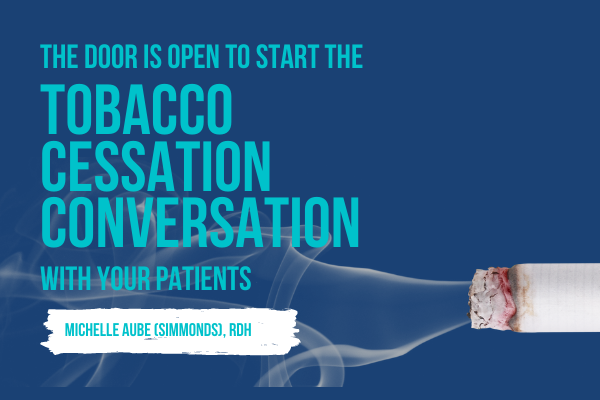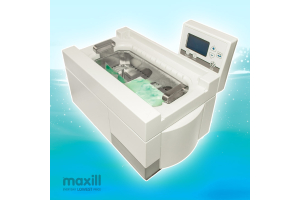Dental Professionals the Door is Wide Open For the Tobacco Cessation Conversation!

It is no secret to the significant educational role the dental professional holds with the oral and systemic health connection. Dental professionals are well aware of the adverse effects smoking has on both soft and hard tissue. Impactful tobacco cessation conversations with clients are not due to lack of knowledge but rather constraints on time management. Let us solve the time barrier right now!
Can you think of the perfect teachable moment for smoking cessation? Or better yet who has given all dental professionals the open door for the conversation and communication about ill impacts of smoking? And the award goes to “The American Academy of Periodontology (AAP)”! With the new periodontitis classification of staging and grading, smoking and diabetes are factors to screen for an accurate grading … well thank you AAP for a wide-open door!
Your action plan revolves around five success measures that are simple to integrate, impactful to client care and all within the scope of practice of the dental professional.
Here is how dental offices can start the Tobacco Cessation Conversation:
- Review medical history form
- Have “Ask Me About Quitting Smoking” visuals around the office
- Shorten the ‘5-A’s’ of smoking cessation
- Referral and professional collaborations
- Provide resource materials
RELATED: Clinical Tobacco Intervention Tips for Dental Offices
Review Medical History Form
Where in the medical history form is the screening question for smoking tobacco and/or cannabis? If it is under habits, then it's time to revamp the medical history form. Smoking is not a habit; it is an addiction. The word habit diminishes the seriousness of the screening aspect of the topic. It’s an addiction so, let's call it an addiction and have the client assume responsibility that they have an addiction. Shifting where the screening sits on the medical history form, automatically categorizes smoking as an addiction and places a priority and urgency on needing to discuss the addiction with a health care professional. Most clients do not view the dental office as the forum where smoking addictions are discussed, but you are a health professional and it's in your scope of practice to screen, educate and discuss.
Some dental professionals find having the smoking cessation conversation difficult. Change the approach, you are not ‘preaching,’ you are not ‘labelling’ and you will not come across as doing so when you support the negative with a positive. As the client is educated on the ill effects of smoking on oral health (the negative) tie in what happens along with timelines of minutes, days, weeks, months, and years in staying quit (the positive). The Centre for Disease Control (CDC) and the Canadian Cancer Society states a person will notice changes in 20 mins! Yes, you read that right … 20 mins. As per the CDC, the following are timelines for these positive manifestations:
- 20 minutes After Quitting: Your heart rate drops.
- 12 hours After Quitting: Your heart attack risk begins to drop and your lung function begins to improve.
- 1 to 9 Months After Quitting: Your coughing and shortness of breath decrease.
- 1 Year After Quitting: Your added risk of coronary heart disease is half that of a smoker.
- 5 Years After Quitting: Your stroke risk is reduced to that of a non-smoker 5-15 years after quitting.
- 10 Years After Quitting: Your lung cancer death rate is about half that of a smoker and your risk of cancers of the mouth, throat, esophagus, bladder, kidney, and pancreas decreases.
- 15 Years After Quitting: Your risk of coronary heart disease is back to that of a non-smoker.
Have “Ask Me About Quitting Smoking” Visuals Around The Office
The visuals tie into the public not being aware the dental health care professional is knowledgeable in smoking addiction and approaches to cessation. So, let's tell them!!! A simple visual in the operatory does the trick (don’t’ worry your visual can be laminated so it meets IPAC standards for AGPs in the operatory!) Visuals come in the form of posters or tripod folds to sit on a counter or posted to a wall and can be downloaded or obtained from your local public health unit for free. Any google search will render countless choices for visuals.
Personally, I have a tripod triangle on my counter (in eyes view for clients) that is fabricated with a laminated paper, and it invites clients to ask me about quitting smoking. Guess what? It works. I do get asked by both smokers and non-smokers. The non-smoker patients comment on how they did not know dental offices offered smoking cessation advice. The visual offers the support the client needs AND it’s educating the public on the dental professional being a health care provider, thus elevating the importance of the dental visit.
Shorten the 5 A’s of Smoking Cessation
As dental offices do not have the luxury of time, we can accommodate the smoking cessation with a shortened approach that is fully evidenced base. It is not a shortcut, but rather salvaging a potential lost teachable moment. Augment your medical history screening with the following motivational interviewing question:
If the score is leaning towards action and the client is ready for change (remembering the cycles of change), the dental professional needs something tangible for a referral and resources (see categories below).
If the score is leaning towards contemplation or pre-contemplation and the client is not yet ready for change, ask the client if it can be discussed again at their next visit. Those two questions will dictate if a referral will be required today or a re-visit to the topic.
At one point or another, the dental professional has learned the 5 A’s of smoking cessation. The World Health Organization (WHO) in their evidenced based Toolkit for Delivering The 5a’s and 5r’s Brief Tobacco Interventions in Primary Care offers 5 A’s as well as 5 R’s. The 5 A’s is a model to assist clients ready to quit. The 5 R’s is a model to increase motivation to quit.
The 5 A's & R's of Smoking Cessation
| The 5 A's of Smoking Cessation | The 5 R's of Smoking Cessation |
|---|---|
|
Ask |
Relevance |
|
Advice |
Risks |
|
Assess |
Rewards |
|
Assist |
Roadblocks |
|
Arrange |
Repetition |
Can you see how the 5R’s needed to be added to the smoking cessation model? Where does the dental professional fit into the 5 A’s and 5 R’s? If the dental office does not have the luxury of time to complete all these 10 steps, at least tackle the 3 A’s of 'ask', 'assist' and 'arrange'. Even the 2 A’s of 'ask' and 'arrange' is beneficial. This is where the shared care circle is important as the dental professional hands the client over to a doctor, nurse, or pharmacist.
Be ready to have conversations with clients having tried quitting and were unsuccessful. Spin what they perceive as a negative outcome to a congratulation with statements such as “Wow, did you know that one day quitting is a big ordeal? Good for you.” The American Cancer Society states “Congratulate the person who's quitting for making a quit attempt, and remind them that it can take many attempts before quitting for good”
RDH, when DDS comes into the operatory for a recare, state the client attempted to quit. DDS, congratulate the client and state the RDH will support their journey if they want a referral to attempt to quit again. Along with the same concept, RDH should tell the DDS when a client did quit smoking and how long they have been smoke free. DDS, even if running behind 20 mins and still needing to do two more recare checks, deliver the most enthusiastic congratulations to that client because the DDS’s encouragement in this exact moment is beyond substantial for sustained client motivation.
Take it a step further with the Smoke Free Curious Campaign offering a tool to calculate the financial savings from quitting
Voila, smoking cessation education done!
Referral and Professional Collaborations
The Smokers Helpline allows for a chairside referral that can be completed in no time at all. Clients can connect via texting by texting the word ‘iQuit’ to a number. Follow this link for the numbers pertaining to different geographical areas. Follow this link to Smokers Helpline for health care professionals.
It's time to expand the shared care circle and include your local public health nurse and pharmacist. Contact your local area public health unit nurse and the pharmacists in the vicinity of the dental office. Set meetings to meet them and let them know you will be referring clients for smoking cessation. They are the professionals who have the time. Two things will happen in this professional collaboration. First, you will gain additional knowledge on the smoking cessation subject with the latest of the latest scientifically based approaches, therefore, keeping you current. Secondly, being well versed on the topic will deliver the confidence you need to educate clients. The expansion of the shared care circle within smoking cessation is a win-win for clinicians and clients.
Resource Material
There are endless resources available to support clients with smoking cessation. The Smokers Helpline has a library for healthcare professionals. If a dental office wants to stay in the realm of paperless, then go the digital route by emailing client links. A better approach, print the main document for the operatory that has QR code capability for the client to scan and obtain the resources immediately. In an electronic society, research apps you may want to suggest to clients. Do not forget that professional dental associations have already performed an evidence-based query and assimilated complimentary resources to download, print, email, etc. A quality education session on any topic is best reinforced with material the client can take home. Will all the smoking cessation discussions result in the client wanting to take home material or want to scan a QR code? No, but for the person sitting on the action stage of the behavioural wheel of change, you have helped THAT person.
To Sum It Up
In conclusion, the five success measures reviewed will deliver a solid action plan for any dental office. Take the information and decide what the structure ‘looks like’ within your typical day. Want to take make this article reading into a goal? Take it one step further with training tools from the Smokers Helpline. Jump at the opportunity of the AAP having graciously opened the door during the A and D of ADPIE when staging and grading the client’s periodontal health. That door is wide open to potentially save someone’s life!
Sources:
- Canadian Cancer Society. Smokers Helpline.
- Centre for Disease Control. Contrasting Trends of Smoking Cessation Status: Insights From the Stages of Change Theory Using Repeat Data From the Global Adult Tobacco Survey, Thailand (2009 and 2011) and Turkey (2008 and 2012). https://www.cdc.gov/pcd/issues/2017/16_0376.htm#:~:text=As%20an%20integrative%20biophysiological%20model,4)%20taking%20action%20to%20quit%20( Original Peer Reviewed Document: Mbulo L, Murty, PhD KS, Husain, PhD MJ, Bashir, MSC R, Blutcher-Nelson, BSc G, Benjakul, PhD S, et al. Contrasting Trends of Smoking Cessation Status: Insights From the Stages of Change Theory Using Repeat Data From the Global Adult Tobacco Survey, Thailand (2009 and 2011) and Turkey (2008 and 2012). Prev Chronic Dis 2017;14:160376. DOI http://dx.doi.org/10.5888/pcd14.160376
- Health Canada. On the Road to Quitting (Jan 2021) ). https://www.canada.ca/content/dam/canada/health-canada/migration/healthy-canadians/publications/healthy-living-vie-saine/non-smoker-adult-non-fumeur-adulte/alt/non-smoker-adult-non-fumeur-adulte-eng.pdf
- Smoke Free Curious Campaign.
- Smokers Helpline. Help a Smoker Quit One Step at a Time.
- Smokers Helpline. You Can Quit One Step at a Time.





